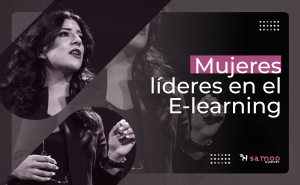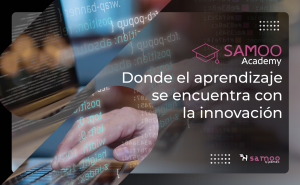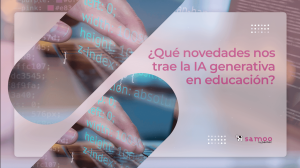HOW TO ORGANIZE "BACK TO SCHOOL" IN TIMES OF PANDEMIC?
Surely you have heard of e-learning; the online learning modality par excellence. But do you know what blended learning (b-learning) is? In today's post we will talk about this training modality, which we have been forced to implement in the COVID19 crisis, and some "tips" that you can implement in it in order to engage your students in the learning process, both face-to-face and online.
Blended learning or hybrid learning is a teaching and learning modality that combines face-to-face and online learning. To this end, educational technology is used to act as a channel for the dissemination of content and interaction between students and teachers. With the return of the new academic year, universities and schools have already started to create collaborative content that encourages student participation. This year, the academic situation accompanied by COVID-19 has led more and more teachers to opt for the integration of pedagogical material in b-learning to ensure student participation in a safe way and to disseminate inclusive content that is accessible to all.
Moving towards a hybrid learning model
Hybrid learning has been used for many years in education, however, it is now especially relevant because of this epidemiological situation. Some key elements of the hybrid modality include digital resources such as forums, SCORM content, PDFs, videos and a learning platform (LMS) that brings together all the educational material and allows students to collaborate with teachers in the online environment.
Its flexibility and autonomy are some of the features that characterize it and have made it so well accepted by both educational institutions and business entities.
What do you need to design a hybrid learning model?
1. Defines the work and evaluation methodology.
When we opt for a blended or blended learning modality, we must work at a pedagogical level on the definition of the methodology to follow and how we are going to evaluate our students.
This first step that right now we are only listing is necessary, in order to be able to select the technological tools that best suit the needs of my hybrid learning model. That is to say, if in my work methodology I propose to carry out synchronous online tutorials on a weekly basis, I will have to select an educational videoconferencing system integrated with my LMS, such as: Blackboard Collaborate.
2. Choose the most suitable platform
By defining the teaching-learning objectives, we will know which are the most appropriate and effective didactic resources for the implementation of our methodology. Once these initial points have been determined, we will be able to select the LMS that best suits the needs of our educational project.
There is a wide range of Learning Management Systems in the world, but when making a choice we must take into account criteria such as:
- Service and support level, in the case of a service model platform, it is important that the SLA to which they commit is higher than 99.5%. In addition, if 24/7 technical support is available, the LMS update and maintenance should be included in the license cost.
- Standard, when choosing an LMS it is essential that it complies with the standards in online training, such as: SCORM 1.2, SCORM 2004, QTI, IMS... In this way, if we want to change platform in the future we should make sure that our didactic contents can be visualized in the same one, this is possible thanks to the standards.
- Administration and customization permissions, in many cases LMSs that are marketed in service format do not provide the customer with full environment administration options, forcing the customer to depend on the provider for the execution of these services.
- Integration with external systems, when we implement an online learning environment it is ideal that it has webservices that allow, for example, to integrate it with our management system in order to automate the registration, deregistration and enrollment of users and thus reduce the workload of the administration profiles, and allows integration by LTI (standard interoperability of learning tools) with which we could implement other tools such as videoconferencing systems, proctoring, gamification, etc..
- Functionalities, it will be necessary to analyze whether the communication services, management tools and didactic resources cover the requirements defined in the learning methodology.
Among our recommendations, for their ease of adaptation for schools, universities or corporate institutions, and of course, for years of experience in the industry, are Blackboard Learn, OpenLMS, Moodle and OKN Learning.
3. Enriches the user experience
In order for the learning project to be a success, it is necessary that the user, both students and teachers, have an excellent user experience, some of the factors that influence it being the following:
- Usability, for which we propose an interface that improves access to information and content, and improves navigation within the learning environment.
- Accessibility, both in classroom and online training, it is essential that the environment as well as the didactic content is inclusive so that all people have access to it. For this, in addition to an adequate web design that complies at least with W3C priorities 1 and 2, we could implement tools such as ReadSpeaker and Blackboard Ally to help us improve the accessibility of learning resources.
- Added value, in order to create a unique experience it will be necessary that our training action provides an added value compared to the competition, this can be achieved in different ways, such as: a proactive tutoring and monitoring of students, with highly interactive teaching content, or with the implementation of differentiating tools (videoconferencing systems, anti-plagiarism, proctoring, etc...).
- Desirable, for this we propose an attractive interface for the user with which we get the engagement of the same.
- Findable, through information architecture we analyze user behavior and their needs with respect to the learning methodology in order to create an environment that responds appropriately.
The best formula for back-to-school: b-learning
Hybrid learning may be a challenge for many, but it is here to stay. Although changing the routine over the traditional way of teaching may be complicated, this new blended learning experience has considerable advantages for the day-to-day life of users and teachers. This increasingly common practice improves student-teacher interaction in learning, increases participation, makes the teaching-learning environment and time more flexible, provides personalized training experiences, reduces training costs and provides access to learning resources 24 hours a day, 7 days a week.
Discover for yourself all the benefits of blended learning and don't forget to design your hybrid classroom first so that everything goes smoothly once the course starts. By following these tips, you are sure to enjoy a full learning experience in the new back-to-school or back-to-university year. And if you still have doubts about how to plan your 2021 - 2022 course and integrate educational technology to enhance learning, contact Samoo for advice from our consultants.
Last entries

Women in e-learning

Leaders in content virtualization

Educational revolution with Samoo Academy

